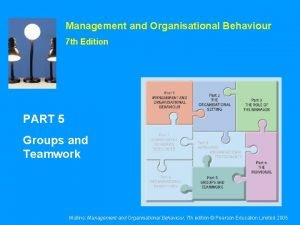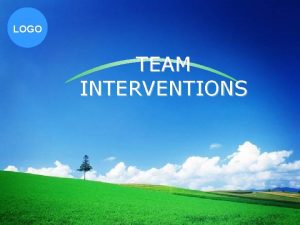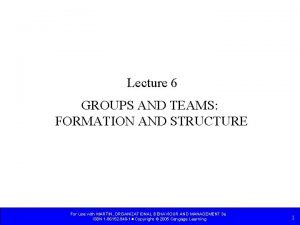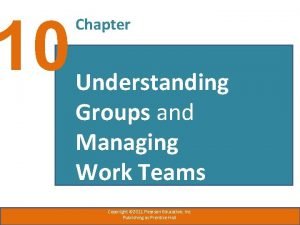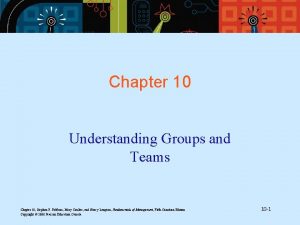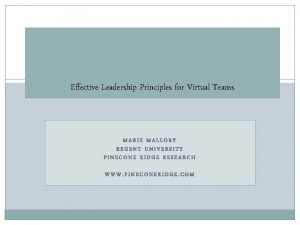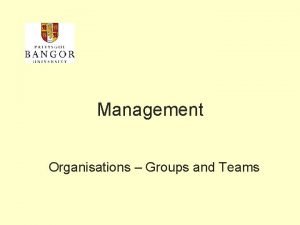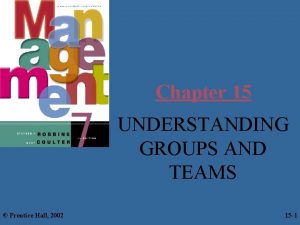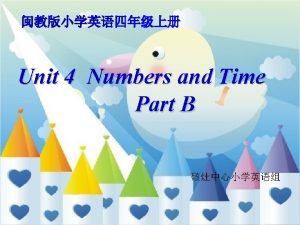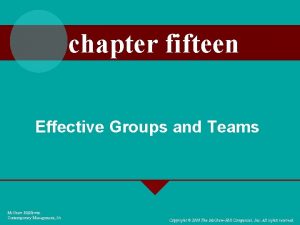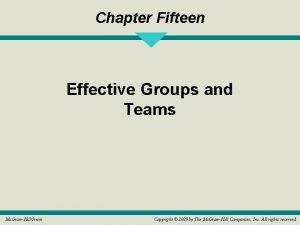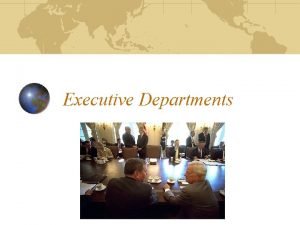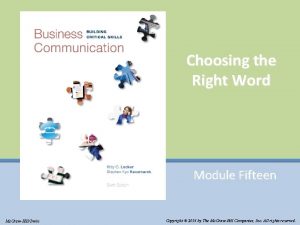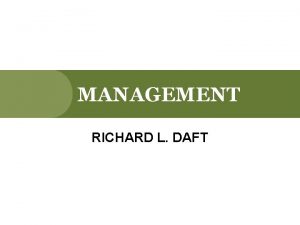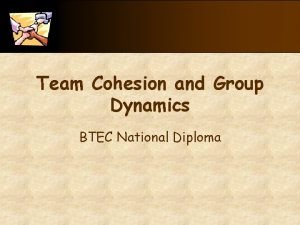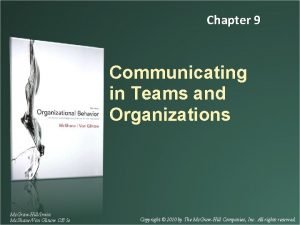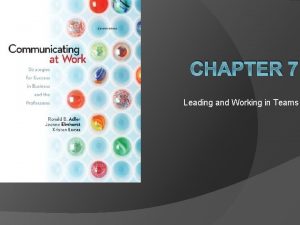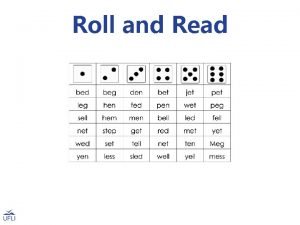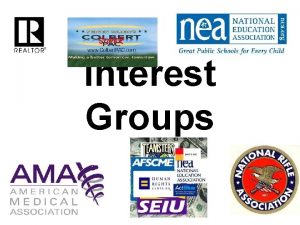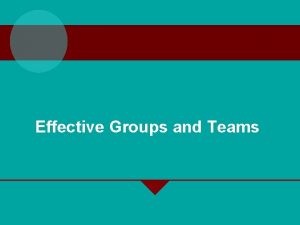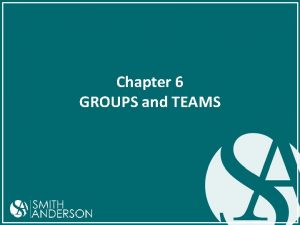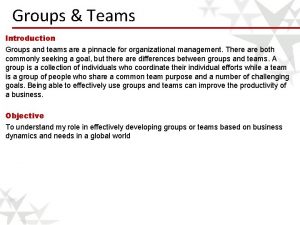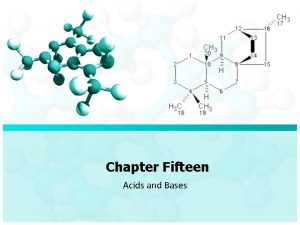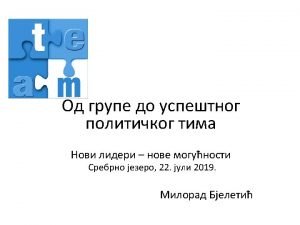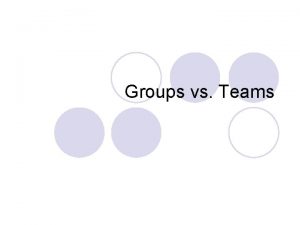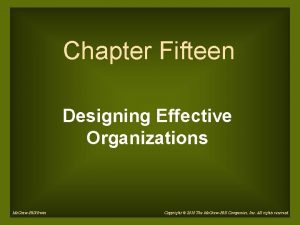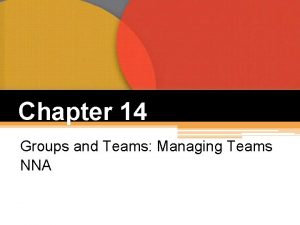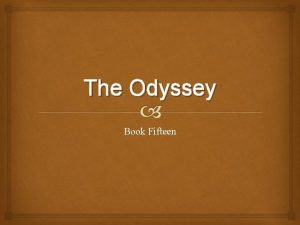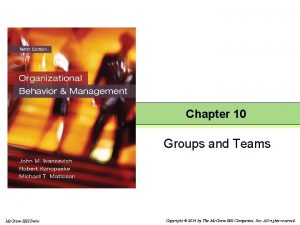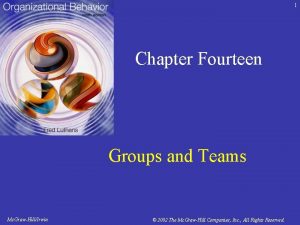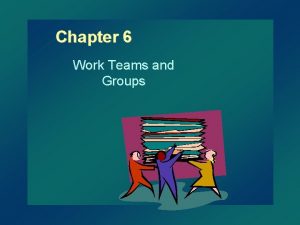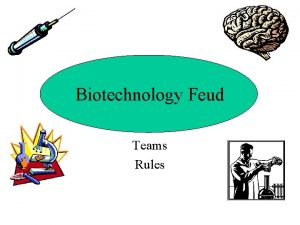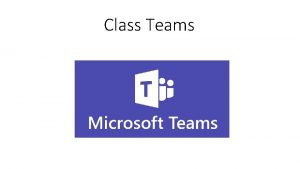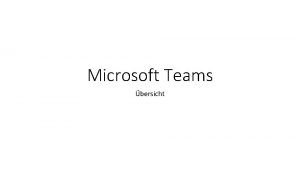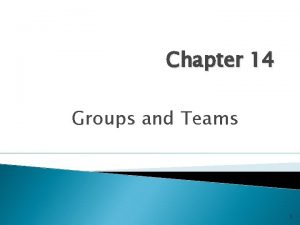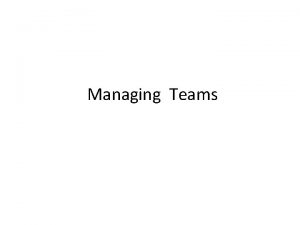Chapter Fifteen Effective Groups and Teams Mc GrawHillIrwin































- Slides: 31

Chapter Fifteen Effective Groups and Teams Mc. Graw-Hill/Irwin Copyright © 2009 by The Mc. Graw-Hill Companies, Inc. All rights reserved.

Groups, Teams and Organizational Effectiveness Ø Group ≈ Two or more people who interact with each other to accomplish certain goals or meet certain needs. 15 -2

Groups, Teams and Organizational Effectiveness Ø Team ≈ A group whose members work intensely with each other to achieve a specific, common goal or objective. ≈ All teams are groups but not all groups are teams. § Teams often are difficult to form. § It takes time for members to learn how to work together. 15 -3

Groups’ and Teams’ Contributions to Organizational Effectiveness Figure 15. 1 15 -4

Groups and Teams as Performance Enhancers Ø Advantage of synergy ≈ People working in a group are able to produce more outputs than would have been produced if each person had worked separately 15 -5

Groups and Teams and Responsiveness to Customers Ø Responsiveness to Customers ≈ May be difficult to achieve given the many constraints. ≈ Cross-functional teams can provide the wide variety of skills needed to meet customer demands. § Teams consist of members of different departments. 15 -6

Teams and Innovation Ø Innovation ≈ The creative development of new products, new technologies, new services, or new organizational structures § Individuals rarely possess the wide variety of skills needed for successful innovation. § Team members can uncover each other’s flaws and balance each other’s strengths and weaknesses 15 -7

Groups and Teams as Motivators Ø Members of groups, and particularly teams, are often better motivated and satisfied than individuals. ≈ Team members are motivated and satisfied than if they were working alone. 15 -8

The Types of Groups and Teams in Organizations Figure 15. 2 15 -9

The Types of Groups and Teams Ø Formal Group ≈ A group that managers establish to achieve organization goals. Ø Informal Group ≈ A group that managers or nonmanagerial employees form to help achieve their own goals or to meet their own needs. 15 -10

The Types of Groups and Teams 15 -11

The Types of Groups and Teams 15 -12

Student Teams Ø Develop skills necessary to work within heterogeneous teams w/ unstructured team dynamics ≈ Learn to assume leadership positions not formally granted by org ≈ Practice effective persuasion skills in order to convince other members to choose certain options in task accomplishment ≈ Motivate others wo/ formal reward system 15 -13

Group Size Ø Advantage of small groups ≈ Interact more with each other and easier to coordinate their efforts ≈ More motivated, satisfied, and committed ≈ Easier to share information ≈ Better able to see the importance of their personal contributions 15 -14

Group Tasks Ø Task interdependence ≈ degree to which the work performed by one member of the group influences the work performed by other members 15 -15

Types of Task Interdependence Figure 15. 3 15 -16

Group Roles Ø Group Roles ≈ The set of behaviors and tasks that a group member is expected to perform because of his or her position in the group. 15 -17

Group Roles Ø In cross-functional teams, members are expected to perform roles in their specialty. Ø Managers should clearly describe expected roles to group members when they are assigned to the group. Ø Role-making occurs as workers take on more responsibility in their roles as group members. Ø Self-managed teams may assign the roles to members themselves. 15 -18

Group Leadership Ø Effective leadership is a key ingredient in high performing groups, teams, and organizations. Ø Formal groups created by an organization have a leader appointed by the organization. Ø Groups that evolve independently in an organization have an informal leader recognized by the group. 15 -19

The Stages of Group Development Figure 15. 4 15 -20

Stages of Group Development Ø Forming ≈ Group members get to know each other and reach common understanding Ø Storming ≈ Group members experience conflict because some members do not wish to submit to demands of other group members § Self-managed teams particularly vulnerable Ø Norming ≈ Close ties and consensus begin to develop between group members. 15 -21

Stages of Group Development Ø Performing ≈ The group begins to do its real work. Ø Adjourning ≈ Only for task forces that are temporary ≈ Group is dispersed 15 -22

Group Norms Ø Group Norms ≈ Shared guidelines or rules for behavior that most group members follow Ø Managers should encourage members to develop norms that contribute to group performance and the attainment of group goals 15 -23

Group Dynamics Ø Conformity and Deviance ≈ Members conform to norms to obtain rewards, imitate respected members, and because they feel the behavior is right. ≈ When a member deviates, other members will try to make them conform, expel the member, or change the group norms to accommodate them. 15 -24

Balancing Conformity and Deviance in Groups Figure 15. 5 15 -25

Sources and Consequences of Group Cohesiveness Figure 15. 6 15 -26

Factors Leading to Group Cohesiveness 15 -27

Managing Groups and Teams for High Performance Ø Motivating group members to achieve organizational goals: ≈ Members should benefit when the group performs well—rewards can be monetary or in other forms such as special recognition. ≈ Individual compensation is a combination of both individual and group performance. 15 -28

Managing Groups and Teams for High Performance Ø Social loafing ≈ The tendency of individuals to put forth less effort in a group than individually. ≈ Results in possibly lower group performance and failure to attain group goals 15 -29

Three Ways to Reduce Social Loafing Figure 15. 7 15 -30

Team Building Ø Any formal intervention directed toward improving development and functioning of work team ≈ Role definition: clarifying obligations, norms ≈ Interpersonal process: building trust and open communication (e. g. , wilderness activities) ≈ Goal setting: clarifying goals, increase goal motivation ≈ Problem-solving: improve team’s decision process 15 -31
 Team and group difference
Team and group difference Groups and teams difference
Groups and teams difference Groups and teams difference
Groups and teams difference Understanding groups and managing work teams
Understanding groups and managing work teams Understanding groups and teams
Understanding groups and teams Understanding groups and teams
Understanding groups and teams Principles of effective leadership in virtual teams
Principles of effective leadership in virtual teams Characteristics of effective teams
Characteristics of effective teams Characteristics of effective teams
Characteristics of effective teams How are ethnic groups and religious groups related
How are ethnic groups and religious groups related Chapter 10 motivating and satisfying employees and teams
Chapter 10 motivating and satisfying employees and teams Is the individual internal process that energizes directs
Is the individual internal process that energizes directs William stafford fifteen
William stafford fifteen One two three four five six numbers
One two three four five six numbers Fifteen william stafford
Fifteen william stafford Benito doesn't don't know the answer
Benito doesn't don't know the answer Dynaway
Dynaway Team fifteen mc
Team fifteen mc Types of task interdependence
Types of task interdependence 15 departments of the cabinet
15 departments of the cabinet Fifteen mc
Fifteen mc Motivating and satisfying employees and teams
Motivating and satisfying employees and teams Motivating and satisfying employees and teams
Motivating and satisfying employees and teams Motivating and satisfying employees and teams
Motivating and satisfying employees and teams Team cohesion examples
Team cohesion examples Peopleware definition
Peopleware definition Persuasive communication
Persuasive communication Leading and working in teams
Leading and working in teams Words with oi oy sound
Words with oi oy sound New deal affects many groups
New deal affects many groups Chapter 9 section 1 the nature of interest groups
Chapter 9 section 1 the nature of interest groups Chapter 10 comparing two populations or groups answer key
Chapter 10 comparing two populations or groups answer key
